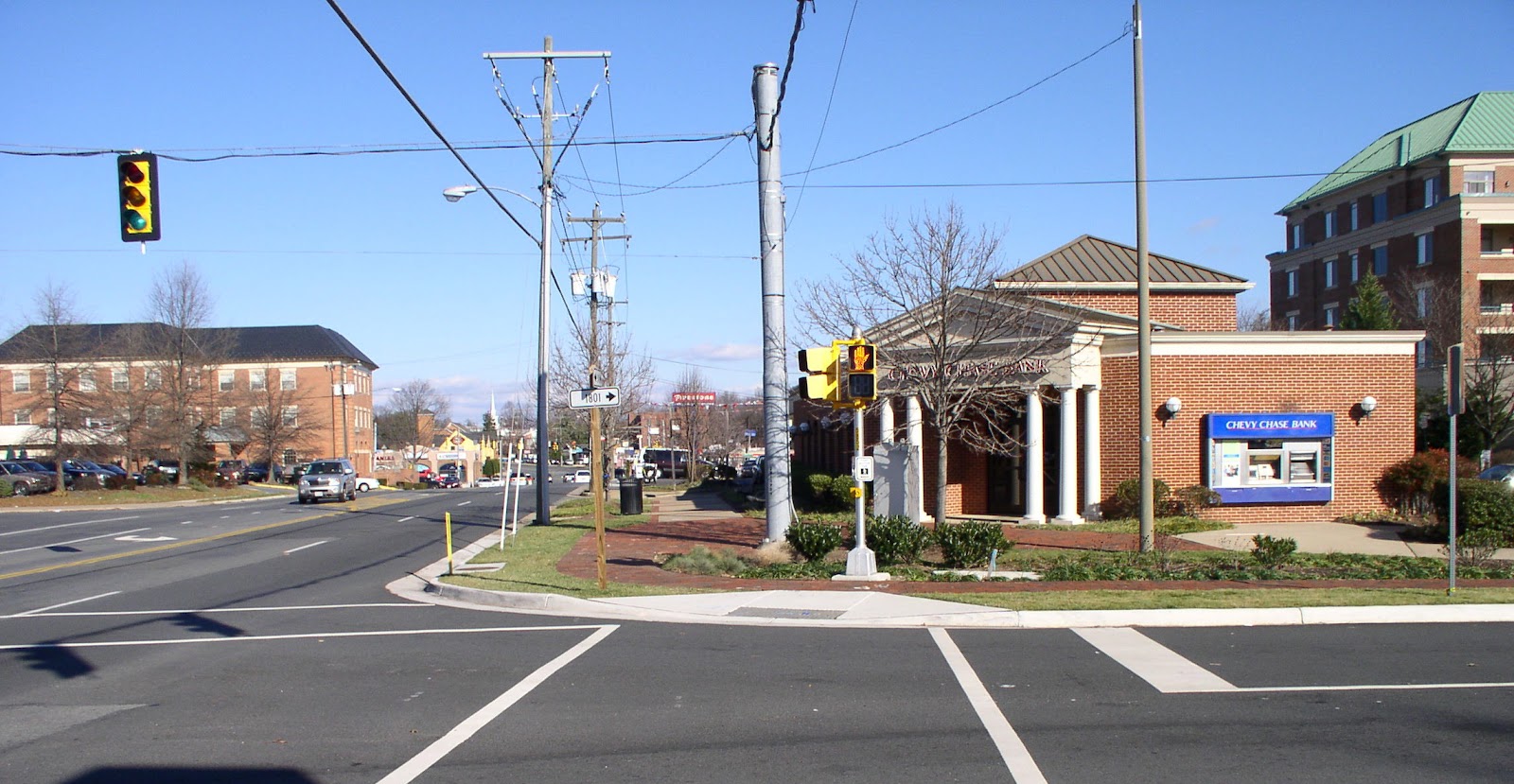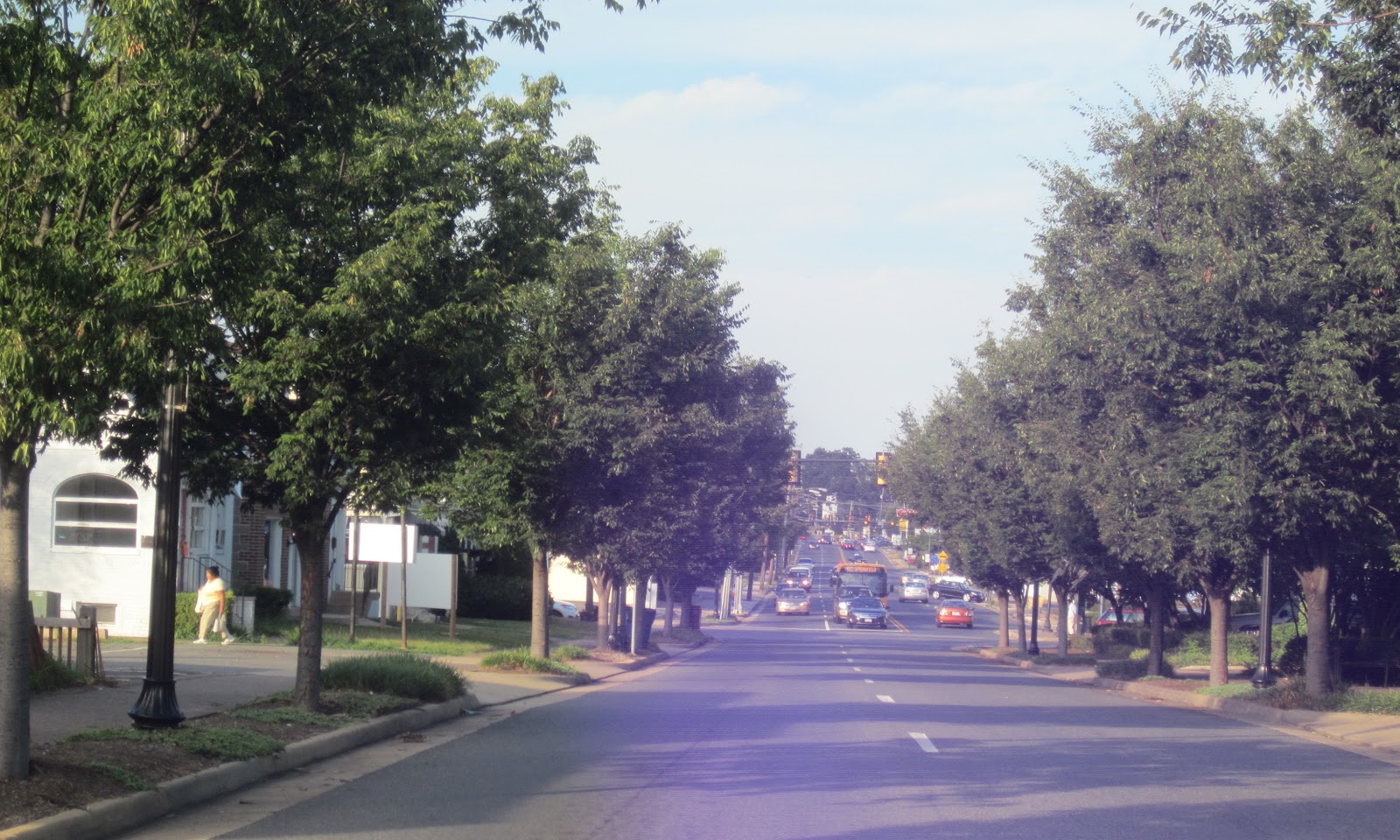Burying utilities in Fairfax County: prohibitively expensive
 |
| The intersection of Old Dominion Drive and Chain Bridge Road in McLean, where the wires will be buried. |
have gotten people wondering why we can’t bury the power lines here.s “amazingly expensive,” says W. Todd Minnix, chief of
the Transportation Design Division in the Fairfax County Department of Transportation.
It’s also very complicated, he says. Construction on a $3.5 million underground utilities project in
McLean started July 9. “It’s been a long, drawn-out process to get this underway,”
Minnix says, noting that it’s been in the works since 1999.
 |
| The wires are buried along this stretch of Columbia Pike |
utilities effort under way now, but it is not the first one. The utilities along one block of Columbia Pike between
Little River Turnpike and Backlick/Annandale roads were buried about 10 years
ago as part of the Annandale demonstration project.
Funding came from a $22.3 million county bond passed in 1988.
The bond included $7.6 million for Annandale, which provided funding for
streetscape improvements, crosswalks, landscaping, and the tiny cannon park, as
well as the buried utilities.
According to Larry Ichter, who was chief of the
Transportation Design Division at the time, the construction
component of the Annandale underground utilities project was about $636,000.
That doesn’t include design and land acquisition.
The McLean project calls for Dominion Power, Cox, and
Verizon wires to be buried along a 1,200-foot stretch of Chain Bridge Road
and 800 feet along Old Dominion Drive in central McLean. The project is part of
a larger revitalization initiative that also includes an improved streetscape
with brick sidewalks and landscaping.
The McLean Revitalization Corporation contributed $1.3
million. The rest of the $3.5 million is from a Fairfax County bond passed
about 10 years ago, with additional funds from the general county budget and
proffers. The cost would have been higher if the affected property owners hadn’t
agreed to grant easements.
It’s taken two years to get the easements for the 16
separate properties affected, Minnix says. That includes three gas stations, three
banks, Chicken Out, Merchant Tire, 7-11, Starbucks, Boston Market, a dry cleaners, Franklin
Sherman Elementary School, and a McDonalds, which has since closed and is being
used as a staging area.
According to Mannix the project costs about $1,750 a linear
foot; if the county had to pay for the
land, the cost would rise to $2,400 to $2,500 a foot. He calculates the cost at
$13 million a mile.
Not everything will be underground. There will be four
Dominion four by eight-foot transformers and switchpads on the surface plus
several small Cox facilities.
Underground utilities minimize—but don’t prevent—power
outages. There won’t be wires that can be knocked down by trees during a storm,
but an outage could still occur if there is a lightning strike. And if there is
an outage, repairs could take longer if the underground wires have to be
accessed.
And while underground utilities reduce overhead clutter,
there would still be street lights. In McLean, the traffic lights would be hung
from poles stretching over the street, rather than wires.
New housing projects often have underground utilities, usually paid for by the developer with the cost passed along to homebuyers. Burying utilities in older, residential neighborhoods would require cutting down a lot of trees. And who would pay for it? It would be difficult to get a bond passed for something like that if it only benefits a small residential area.


Good article on covering both sides of the argument and providing past cost estimates. I think its one of those things that older more established neighborhoods prefer their trees and are fine with overhead power, and newer development will utilize below ground incorporated into the redevelopment.
One of the biggest problems with going underground is also dependent on how much other stuff is down there with it. A lot of people have no idea about the interweave of utilities underneath our feet from gas, to telecomm (of all sorts and generations), storm, sanitary, water, fire hydrant lines, and a myriad of miscellaneous systems. The more developed an area (like DC) the more costly per linear foot.
Keep up the great writing
I do not think I would trust the numbers provided by the power company on the expense of burying lines. I would rather a truly independent company with no ties to the power company do a true analysis of costs to not bury all the lines but perhaps those in the most 'at risk' communities. This last storm may have been unexpected but my power goes off for a day with just a single gust of wind. It goes out more and more and for longer and longer and this tells me the power company is prepared for the status quo and is not doing anything to improve their prevention or ability to respond timely in a wide range of weather conditions.
It's time they sink some of their profits into hiring people, even if seasonal, investing in more equipment, and planning for disasters instead of only being able to respond to routine and minor failures.
How is it that all other advanced countries can bury theirs? Have you watched the Tour de France? Very few cables and NO bill boards. What a delightful place to live in.
In fact "all" other advanced countries do not bury their lines. In Australia no less than 1/2 of the homes have their power lines buried. I personally am not anxious to borrow more money from China just so millions of overweight and under conditioned American's can wallow around their homes cool under their blubber blankets. I say it is cheaper to eat less and allow the blood to cool naturally. What has this country become?
The county/town whatever should require developers to bury lines.
Im afraid we are moving up! That is to third world country status. As our elected officials focus on themselves, their bank accounts, who is in the bedroom, the definition of marriage and any other nonsense that keeps them from doing their job, the cities and the suburbs of this once great land are looking more like the slums of Central America than the great cities of our European ancestoral origins. If you did not invest in your home, your education and your hygiene, what do you think your earning power would be……..zilch! That is where we are today in the US……nowhere! We will soon all need to own our personal generators, police force, ambulance and fire department. God help us, should we ever get attacked by aliens, we will surely be doomed into surrender without a light bulb to help us find our way to safe havens. We can only help that the Chinese will save us!
The costs of burying power lines are the same per mile regardless of density, pretty much, AFAIK. but the benefits are higher when density is greater (more households and businesses without power) So doing this makes sense where density is higher, and in areas targeted for additional development.
I take it you support bike lanes and road diets to get more FFX people down to healthy weights and in better condition?